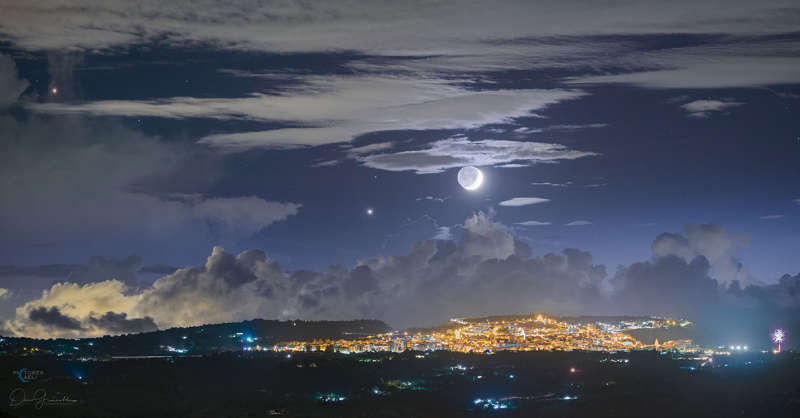Credit & Copyright:
Dario Giannobile
Explanation:
Why can we see the entire face of this Moon?
When the
Moon is in a crescent phase,
only part of it appears directly illuminated by the
Sun.
The answer is earthshine,
also known as
earthlight and the
da Vinci glow.
The reason is that the rest of the
Earth-facing Moon
is slightly illuminated by sunlight first reflected from the Earth.
Since the Earth appears near full phase from the
Moon -- when the
Moon appears as a slight crescent
from the Earth --
earthshine is then near its brightest.
Featured here in combined, consecutively-taken,
HDR images
taken earlier this month, a
rising earthshine Moon
was captured passing slowly near the
planet Venus,
the brightest spot near the image center.
Just above Venus is the star
Dschubba (catalogued as
Delta Scorpii),
while the red star on the far left is
Antares.
The
celestial show is visible through scenic cloud decks.
In the foreground are the lights from
Palazzolo Acreide, a
city with ancient
historical roots in
Sicily,
Italy.
1999 2000 2001 2002 2003 2004 2005 2006 2007 2008 2009 2010 2011 2012 2013 2014 2015 2016 2017 2018 2019 2020 2021 2022 2023 2024 2025 |
Yanvar' Fevral' Mart Aprel' Mai Iyun' Iyul' Avgust Sentyabr' Oktyabr' Noyabr' Dekabr' |
NASA Web Site Statements, Warnings, and Disclaimers
NASA Official: Jay Norris. Specific rights apply.
A service of: LHEA at NASA / GSFC
& Michigan Tech. U.
|
Publikacii s klyuchevymi slovami:
Moon - Luna - Pepel'nyi svet luny
Publikacii so slovami: Moon - Luna - Pepel'nyi svet luny | |
Sm. takzhe:
Vse publikacii na tu zhe temu >> | |
